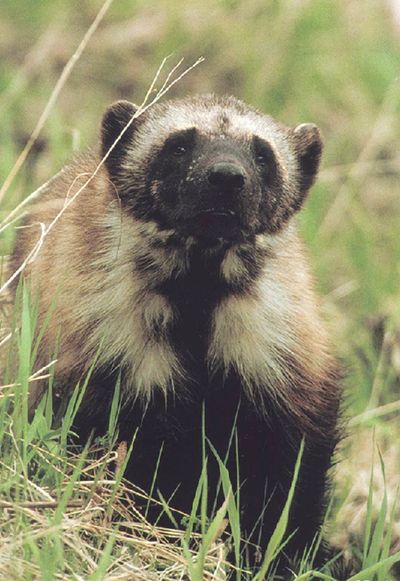Wolverine’s long journey tracked
Female has traveled hundreds of miles

TWISP, Wash. – The latest capture in the North Cascades’ first wolverine study has embarked on a journey that is surprising even the wildlife biologists who are studying her.
Trapped in a log cage up the Twisp River, radio-collared and released on Feb. 1, Eowyn immediately left the area, headed south into the Chelan watershed, then turned north. And she kept on going, ending up in Kamloops, B.C., which is 150 miles on a straight line.
Using data from the radio-telemetry collar she wears, scientists know she hung out at a suburban golf course, then went west and crossed the large Fraser River east of Vancouver, B.C.
She now appears to be curving back down toward Washington state through western British Columbia.
“That kind of a continuous trek, covering great distances, is something a male wolverine might do when they’re out looking for a mate,” said Keith Aubry, research biologist for the U.S. Forest Services Research Station, who is heading the wolverine study. “It’s not the kind of thing you’d expect a juvenile female to do.”
Even one named after a fictional noblewoman from “The Lord of the Rings” who fancied herself a warrior.
Sasha, last year’s only capture, also immediately left the Twisp River, but stayed closer, heading east toward Holden and the Entiat River drainage.
This is the first study in the North Cascades of wolverines, considered by scientists to be a sensitive species and a candidate for protection under the Endangered Species Act.
This is the second year that John Rohrer, biologist for the Methow Valley Ranger District, has captured a young female in the Twisp River area only to see her leave. He said it’s too soon to know whether these young wolverines were born here and left to find a new place to call home, or whether they were just traveling through the Twisp River area when they got waylaid by his trap.
“Sasha appeared to stay in the Entiat drainage, but Eowyn, she hasn’t stopped anywhere long enough for it to be home,” Rohrer said.
Biologists on Wednesday closed up the last of 10 wolverine traps set in various locations above the Methow Valley this winter. They’ll continue to track the movements of Eowyn and two other wolverines trapped in British Columbia this winter and fitted with radio collars.
This is the second year of collaboration with scientists from the British Columbia Ministry of the Environment, who have also set up traps and remote cameras north of the border. Not surprisingly, some of the same wolverines captured in the Methow Valley in past years were captured in traps or on camera in Canada, Aubry said.
“So we reconnected with at least three animals that we’d lost track of for at least two years,” he said. Aubrey said photographs can often provide enough proof that they’re looking at a certain individual, because the white markings on their chests are usually different enough to identify them.
Aubry and his crew set up 16 remote cameras in the U.S. and Canada using a technique designed by a biologist in Alaska to capture images of those markings. It includes a pole attached to a tree about 3 feet up, at a 90-degree angle. The wolverine walks to the end of the pole, lured by hanging bait. A remote camera takes the animal’s picture while it looks up and debates whether to jump or stand on its hind feet to get the reward. This method will help biologists learn if there are wolverines in their study area that aren’t being captured in traps. It will also identify whether previously captured animals are still around.
Aubry said data from his study was used in an article published last week in the Canadian Journal of Zoology. The study showed wolverines are closely tied to habitat where the snow remains from mid-April to mid-May. To reach this conclusion, scientists used satellite images of areas where snow persists in the spring, and overlaid them on maps that show where radio-collared wolverines had traveled, Aubrey said. He said his data supported the conclusion.